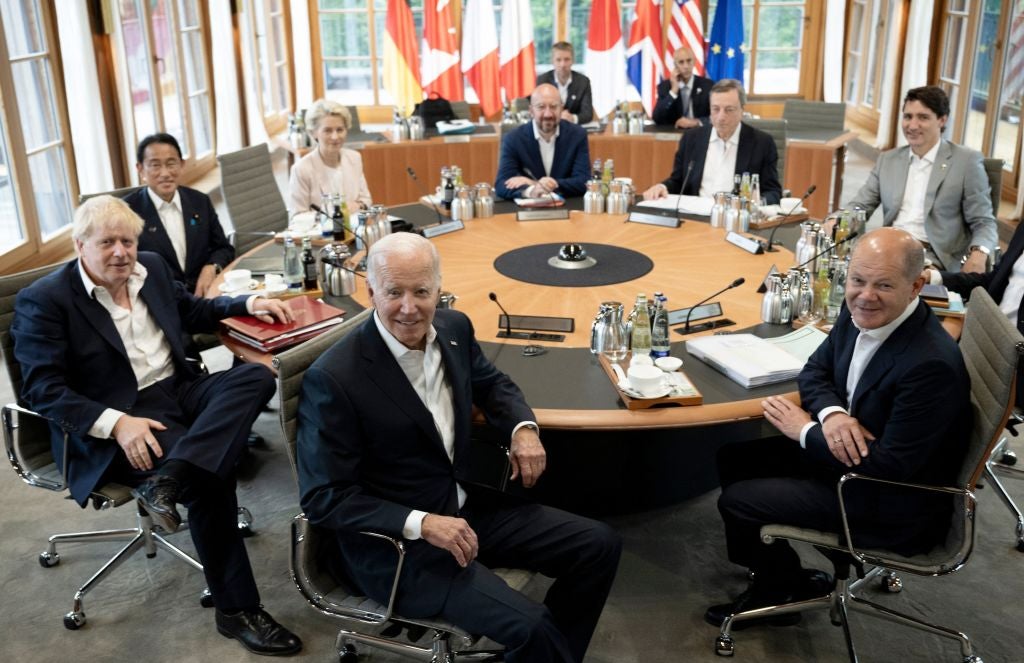
When it comes to climate, the G7 leaders had big talk but little action at their summit in Germany at the end of June. They failed to reach a unanimous agreement to phase out fossil fuel subsidies – and even watered down a previous commitment by six of them by adding an exemption for gas investments in light of the Ukraine war. They did recommit to achieving a fully or predominantly decarbonised power sector by 2035.
In their conclusions, the leaders of the world’s seven largest economies “[noted] with concern that currently neither global climate ambition nor implementation are sufficient to achieve the goals of the Paris Agreement”. For that reason, the G7 agreed to establish a “climate club” – a group of like-minded countries that would agree joint rules and standards in the fight against climate change – by the end of 2022. It would “support the effective implementation of the Paris Agreement by accelerating climate action and increasing ambition, with a particular focus on industry, thereby addressing risks of carbon leakage for emission intensive goods, while complying with international [trade] rules”.
The club will have three pillars: one, developing a common way to measure efforts toward mitigation; two, decarbonising industry; and three, boosting international ambition through partnerships and cooperation. Other than that, there were few details. However, analysts say the three pillars give some clues about the club’s eventual course. Domien Vangenechten, a policy advisor at climate think tank E3G, says the decarbonisation of industry is “at the heart of the initiative”.
“While the idea to focus [global cooperation] on carbon pricing has lost steam, the pivot to heavy industry has the potential to accelerate the development of global green markets [for new technologies],” he says. “G7 countries now need to develop clear terms of reference with a view to incorporating key partners with a high level of climate ambition.”
Cover for CBAM?
Who will be in this climate club? Some believe it is merely a cover for preventing international objection to the EU’s incoming Carbon Border Adjustment Mechanism (CBAM), a carbon levy on imports from countries with less stringent climate legislation. Washington has been lobbying EU lawmakers to slow down on the legislation to allow the G7 to come up with a common framework for all of them to develop such levies. The climate club is likely a first step toward this, although there is a doubt in Brussels over whether the US can ever really have such a levy given it has no national price on carbon; for example, via an emissions trading system. Is the climate club meant simply as a list of countries to which CBAM will not apply?
[Keep up with Energy Monitor: Subscribe to our weekly newsletter]
The G7 were keen to stress that the club will be inclusive and is meant as a motivator to all countries to up climate action. “We invite partners, including major emitters, G20 members and other developing and emerging economies, to intensify discussions and consultations with us on this matter,” the leaders said in a statement. However, other parts of the same statement made the club’s ambitions seem much more limited. One of its immediate aims, the G7 said, will be to work towards a common understanding to equalise the burden on industries under carbon pricing regimes with that on industries facing “other carbon mitigation approaches and carbon intensities”. That appears designed for the US, which does not have any plans for emissions trading but does not want to end up on the wrong side of the EU’s CBAM.
But what about the global South? “The ‘open’ climate club statement is a significant step, but much remains to be done, including making sure it is really inclusive,” says Mats Engström, an analyst with the European Council on Foreign Relations, a think tank. “The G7 and the EU need to step up cooperation with developing countries on energy and industrial decarbonisation, including a multilateral co-innovation fund.”
New financing
The G7 did have some new announcements on global financing initiatives. The leaders said they are aiming to mobilise $600bn (€573.85bn) by 2027 for a global infrastructure programme, a still-unspecified proportion of which would be ring-fenced for climate change mitigation and adaptation. The funding is aimed at low and middle-income countries and is meant as an alternative to China’s $10trn Belt and Road initiative.
In a related announcement, the G7 endorsed the European Investment Bank’s €500m Emerging Market Climate Action Fund as a vehicle to mobilise private investments for climate-relevant infrastructure. Germany announced an increase to its investment in the fund of an additional €30m, bringing its total contribution to €55m.
The G7 also announced a “global shield against climate risk” – a collaboration to tackle adaptation – and more Just Energy Transition Partnerships (JETPs). The first of these JETPs, with South Africa, was announced at last year’s COP26 summit in Glasgow. These partnerships would see wealthy countries give both financial and technical help to developing countries for their efforts to tackle climate change. The process has been slow, however, and so far negotiations with Indonesia, India, Senegal and Vietnam have not yielded much progress in setting up actual partnerships.
All these concepts are at an early stage, with few details yet spelled out. While no major new climate announcements were made at the G7, it did give an idea of the intended direction of travel for the world’s wealthiest countries. The big question is whether further global instability, both economic and geopolitical, will cause climate concerns to be relegated to a back seat in the coming year.
This article originally appeared on our sister website Energy Monitor.



